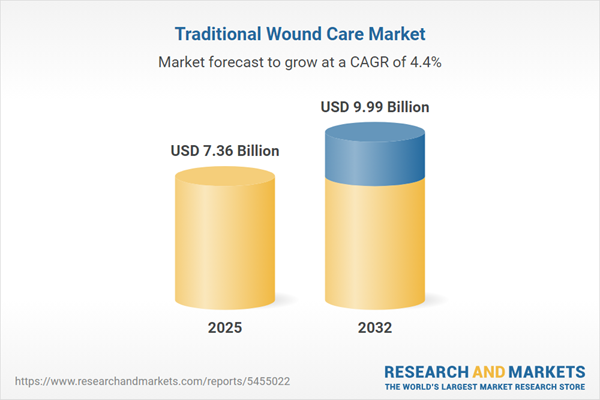Speak directly to the analyst to clarify any post sales queries you may have.
The traditional wound care market forms an essential pillar of global healthcare, sustaining patient recovery through clinically proven products and robust supply chains. As healthcare ecosystems face increasing complexity, reliable wound management solutions remain fundamental for providers worldwide.
Market Snapshot: Traditional Wound Care Market Size and Growth Drivers
The traditional wound care market grew from USD 7.05 billion in 2024 to USD 7.36 billion in 2025. It is expected to continue growing at a CAGR of 4.44%, reaching USD 9.99 billion by 2032. Rising incidence of chronic disease, the aging patient population, and increased procedural volumes are fueling steady demand for foundational wound care products. Evolving reimbursement models and tighter regulations have refocused decision-makers on the relative performance, cost-efficiency, and safety provided by established portfolios. Supply chain integrity and procurement agility now play a decisive role, as do ongoing advancements in dressing technology and material innovation.
Scope & Segmentation
- Product Types: Cohesive bandages, compression bandages, elastic bandages, adhesive dressings, non-adherent dressings, non-woven gauze, woven gauze, cloth tape, paper tape, and plastic tape.
- Wound Types: Burns, surgical wounds, traumatic wounds, arterial ulcers, diabetic foot ulcers, pressure ulcers, and venous leg ulcers.
- Material Types: Cellulose, cotton, polyester, polyurethane.
- End Users: Ambulatory care centers, clinics, home care settings, hospitals.
- Distribution Channels: Department stores, direct sales, specialty stores, company websites, e-commerce platforms.
- Regions: North America (United States, Canada, Mexico), Latin America (Brazil, Argentina, Chile, Colombia, Peru), Europe (United Kingdom, Germany, France, Russia, Italy, Spain, Netherlands, Sweden, Poland, Switzerland), Middle East (United Arab Emirates, Saudi Arabia, Qatar, Turkey, Israel), Africa (South Africa, Nigeria, Egypt, Kenya), Asia-Pacific (China, India, Japan, Australia, South Korea, Indonesia, Thailand, Malaysia, Singapore, Taiwan).
- Leading Companies: 3M Company, B. Braun SE, Allied Healthcare Products Inc. by Flexicare (Group) Limited, Beiersdorf AG, BSN Medical, Cardinal Health, ConvaTec Group PLC, Cotton Craft (Pvt.) Ltd., Dynarex Corporation, Essity AB, Gentell Inc., Harro Höfliger Verpackungsmaschinen GmbH, Johnson & Johnson Services, McKesson Corporation, Medline Industries, Mölnlycke Health Care, Nipro Corporation, Nitto Denko Corporation, Owens & Minor, Paul Hartmann, Smith & Nephew, Urgo Medical, Winner Medical, Axio Biosolutions.
Key Takeaways for Senior Decision-Makers
- Traditional wound care products remain a staple in both acute and chronic settings despite the emergence of advanced wound technologies.
- Procurement models are shifting in response to new supply chain challenges, driving the adoption of digital and direct sourcing platforms for improved cost visibility and responsiveness.
- Material innovation emphasizes enhanced absorption, bacterial barrier efficacy, and sustainability, with both natural and synthetic substrates competing on clinical and environmental performance.
- Regional regulatory variations require adaptive go-to-market strategies and localized partnerships to address diverse infrastructure and patient needs.
- Collaborative development between manufacturers and providers generates actionable clinical evidence, strengthening product positioning and stakeholder trust.
- Data-driven insights from analytics tools are becoming integral for tracking patient outcomes, refining inventory management, and supporting value-based purchasing decisions.
Tariff Impact on Supply and Manufacturing
The 2025 United States tariff adjustments have prompted manufacturers to revisit raw material sourcing and operational strategies. Increased duties on cotton and synthetic inputs led to diversification of supplier bases and implementation of more rigorous quality assurance for new materials. Production footprint localization and automation initiatives are helping mitigate cost increases, while distributors and providers adapt contract terms to the evolving cost structure. These actions strengthen industry resilience against ongoing trade uncertainties.
Research Methodology & Data Sources
Insights in this report derive from a combined quantitative and qualitative methodology. Proprietary transaction data and procurement records underpin distribution and shipment analyses. In-depth interviews with clinicians, procurement directors, and regulatory specialists complement secondary research from peer-reviewed publications and industry filings. Facility audits and supplier disclosures enable a comparative perspective on manufacturing and logistics, resulting in a well-rounded market view.
Why This Report Matters
- Equips executives with segmented market intelligence to support strategic growth initiatives and product positioning decisions in traditional wound care.
- Clarifies the interplay of tariff policy, supply chain adjustments, and regulatory dynamics critical for risk mitigation and operational planning.
- Offers actionable perspectives for aligning innovation, procurement, and distribution against evolving end-user and regional demands.
Conclusion
Traditional wound care continues to evolve across products, channels, and regions. Senior leaders who leverage market segmentation, regulatory awareness, and digital innovation will be well-positioned for sustainable value creation and competitive advantage.
Additional Product Information:
- Purchase of this report includes 1 year online access with quarterly updates.
- This report can be updated on request. Please contact our Customer Experience team using the Ask a Question widget on our website.
Table of Contents
3. Executive Summary
4. Market Overview
7. Cumulative Impact of Artificial Intelligence 2025
Companies Mentioned
The companies profiled in this Traditional Wound Care market report include:- 3M Company
- B. Braun SE
- Allied Healthcare Products Inc. by Flexicare (Group) Limited
- Beiersdorf AG
- BSN Medical, Inc.
- Cardinal Health, Inc.
- ConvaTec Group PLC
- Cotton Craft (Pvt.) Ltd.
- Dynarex Corporation
- Essity AB
- Gentell, Inc.
- Harro Höfliger Verpackungsmaschinen GmbH
- Johnson & Johnson Services, Inc.
- McKesson Corporation
- Medline Industries, Inc.
- Mölnlycke Health Care AB
- Nipro Corporation
- Nitto Denko Corporation
- Owens & Minor, Inc.
- Paul Hartmann AG
- Smith & Nephew plc
- Urgo Medical Group
- Winner Medical Co., Ltd.
- Axio Biosolutions Pvt Ltd
Table Information
| Report Attribute | Details |
|---|---|
| No. of Pages | 186 |
| Published | November 2025 |
| Forecast Period | 2025 - 2032 |
| Estimated Market Value ( USD | $ 7.36 Billion |
| Forecasted Market Value ( USD | $ 9.99 Billion |
| Compound Annual Growth Rate | 4.4% |
| Regions Covered | Global |
| No. of Companies Mentioned | 25 |









